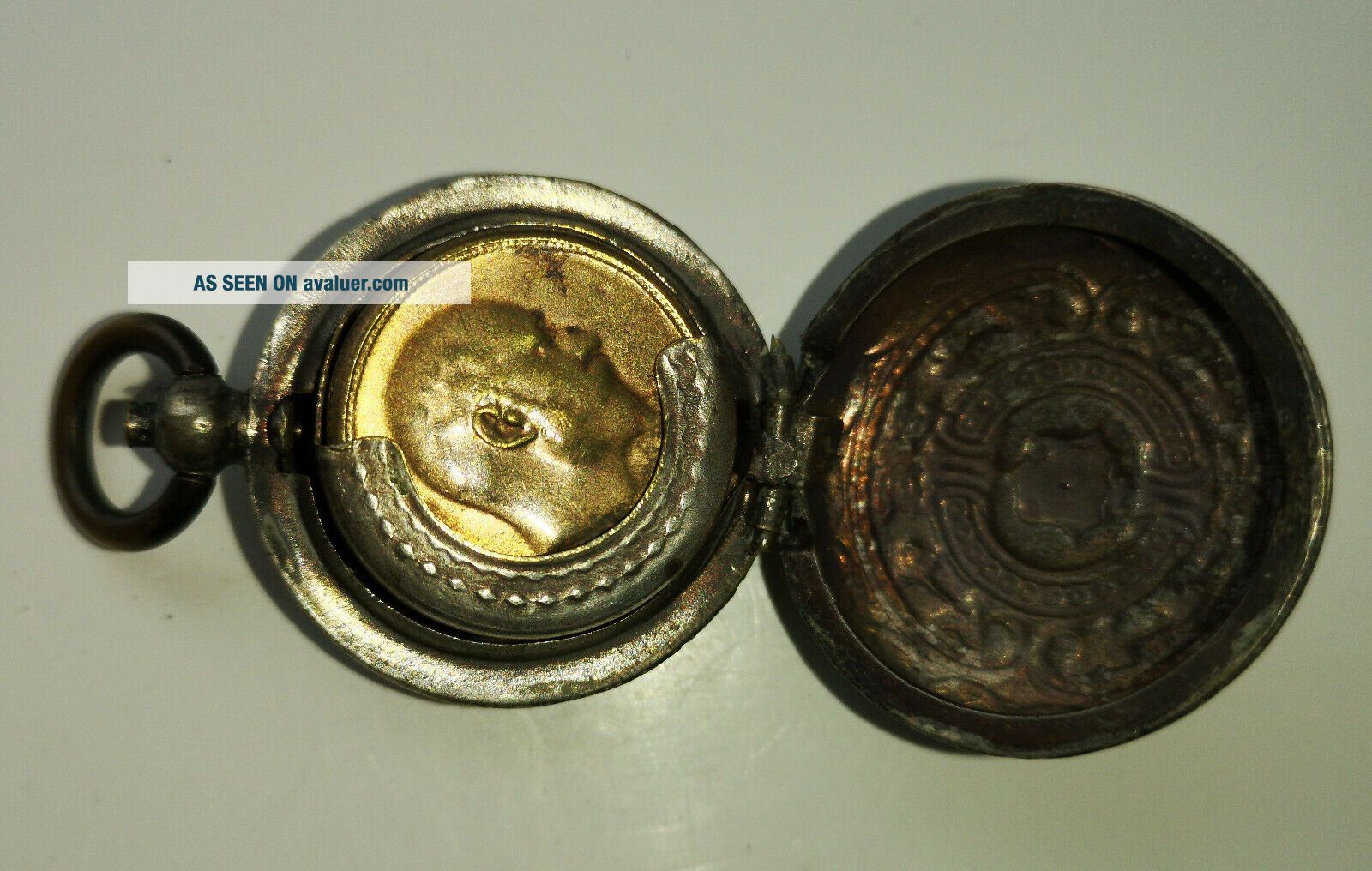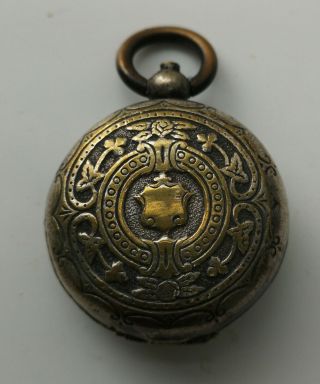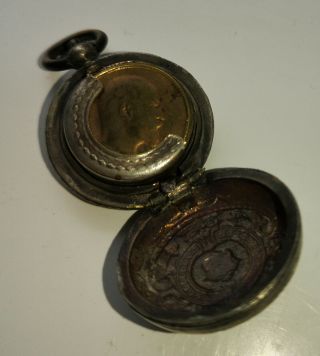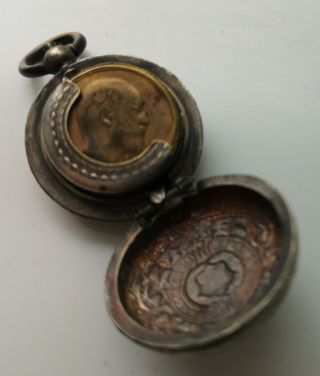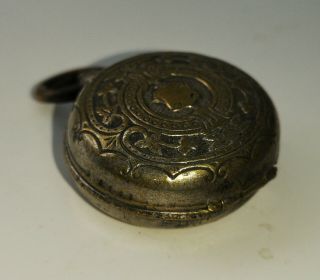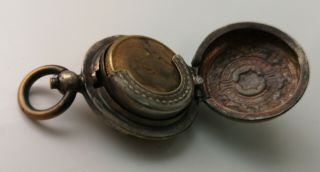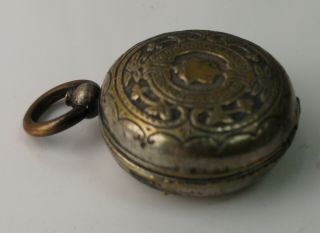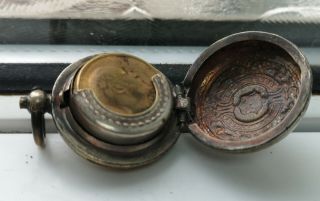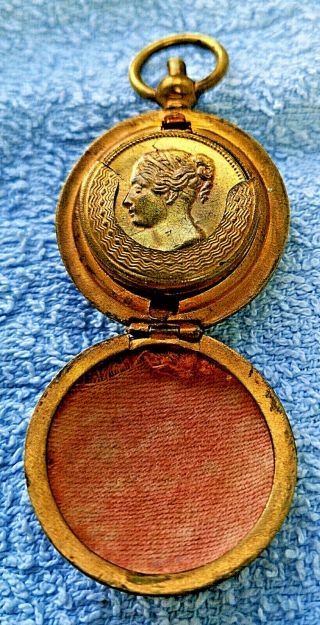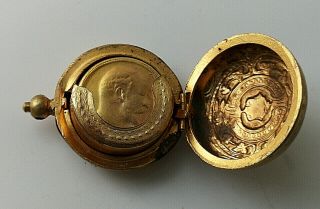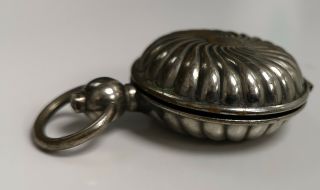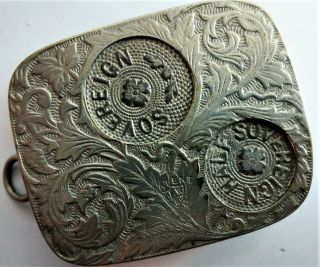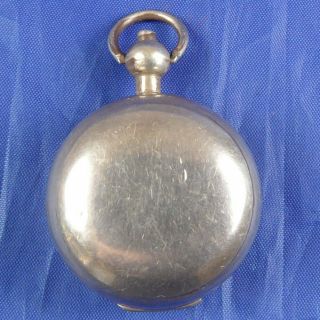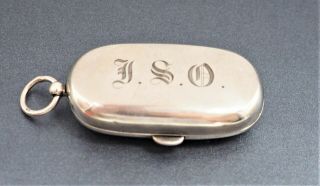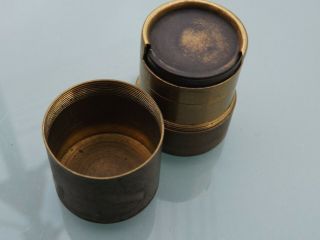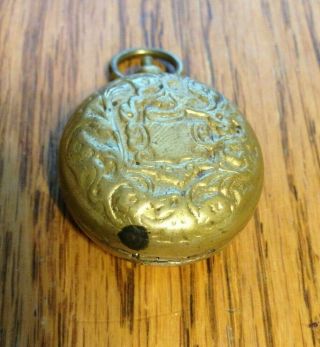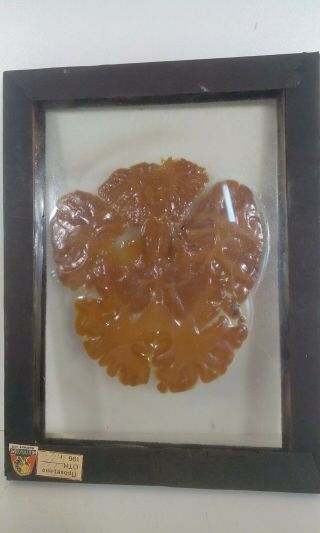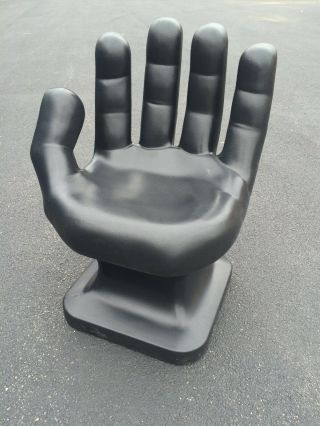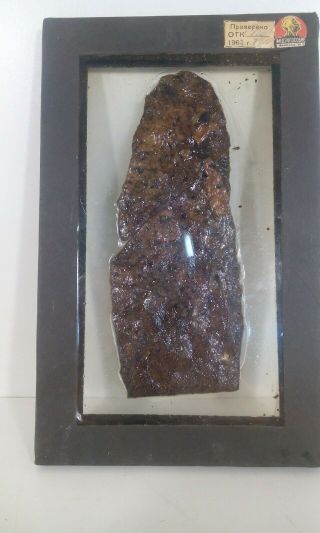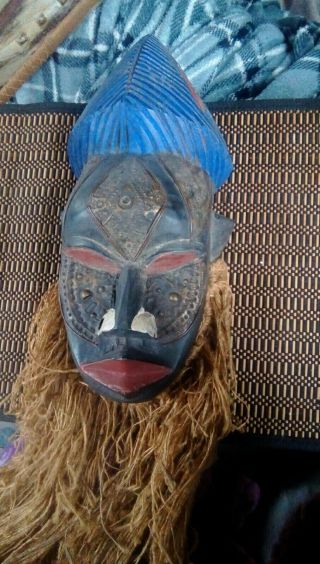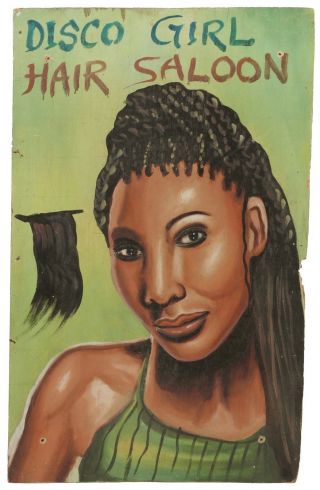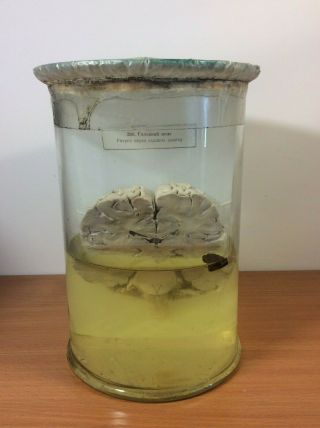Antique Sovereign Coin Holder Wallet Old Brass Gold Lustre Interesting Vintage U
Item History & Price
Antique Coin Wallett
Georgian Brass Sovereign Coin Holder
When openend It has an image of either King Edward VII or his son King George V I am unsure which king as the were alikeit has a spring underneath
Sovereigns can be inserted and held safelty and securely
Very collectable and dates to the early part of the 1900's.
It measures 32 mm diameter and 50 mm long including the top ring.It is
It is in Good Working ...Condition and the springs work fine
In Very Good Condition given it is over 100 years old
Would make an Excellent Lucky Charm or Collectible Keepsake Souvenir
I have a lot more World Cup Items on Ebay >>> CLICK HERE TO VISIT MY SHOP Buy with Confidence please read my feedback from over 14, 000 satisfied customer
Read how quickly they receive their items - I post all my items within 24 hours of receiving payment
International customers are welcome. I have shipped items to over 120 countries
International orders may require longer handling time if held up at customs
If there is a problem I always give a full refund
Returns are acceptedIf your unhappy with your item please return it for a full refund
I am a UK Seller with over 10 Years of eBay Selling Experience
Why not treat yourself?
I always combine multiple items and send an invoice with discounted postage
I leave instant feedback upon receiving yours
All payment methods accepted from all countries in all currencies
Are you looking for a Interesting conversation piece?
A birthday present for the person who has everything?A comical gift to cheer someone up?
or a special unique gift just to say thank you?
You now know where to look for a bargain!Please Take a Moment Click Here to Check Out My Other items *** Please Do Not Click Here ***Click Here to Add me to Your List of Favorite SellersI have sold items to coutries such as Afghanistan * Albania * Algeria * American Samoa (US) * Andorra * Angola * Anguilla (GB) * Antigua and Barbuda * Argentina * Armenia * Aruba (NL) * Australia * Austria * Azerbaijan * Bahamas * Bahrain * Bangladesh * Barbados * Belarus * Belgium * Belize * Benin * Bermuda (GB) * Bhutan * Bolivia * Bonaire (NL) * Bosnia and Herzegovina * Botswana * Bouvet Island (NO) * Brazil * British Indian Ocean Territory (GB) * British Virgin Islands (GB) * Brunei * Bulgaria * Burkina Faso * Burundi * Cambodia * Cameroon * Canada * Cape Verde * Cayman Islands (GB) * Central African Republic * Chad * Chile * China * Christmas Island (AU) * Cocos Islands (AU) * Colombia * Comoros * Congo * Democratic Republic of the Congo * Cook Islands (NZ) * Coral Sea Islands Territory (AU) * Costa Rica * Croatia * Cuba * Curaçao (NL) * Cyprus * Czech Republic * Denmark * Djibouti * Dominica * Dominican Republic * East Timor * Ecuador * Egypt * El Salvador * Equatorial Guinea * Eritrea * Estonia * Ethiopia * Falkland Islands (GB) * Faroe Islands (DK) * Fiji Islands * Finland * France * French Guiana (FR) * French Polynesia (FR) * French Southern Lands (FR) * Gabon * Gambia * Georgia * Germany * Ghana * Gibraltar (GB) * Greece * Greenland (DK) * Grenada * Guadeloupe (FR) * Guam (US) * Guatemala * Guernsey (GB) * Guinea * Guinea-Bissau * Guyana * Haiti * Heard and McDonald Islands (AU) * Honduras * Hong Kong (CN) * Hungary * Iceland * India * Indonesia * Iran * Iraq * Ireland * Isle of Man (GB) * Israel * Italy * Ivory Coast * Jamaica * Jan Mayen (NO) * Japan * Jersey (GB) * Jordan * Kazakhstan * Kenya * Kiribati * Kosovo * Kuwait * Kyrgyzstan * Laos * Latvia * Lebanon * Lesotho * Liberia * Libya * Liechtenstein * Lithuania * Luxembourg * Macau (CN) * Macedonia * Madagascar * Malawi * Malaysia * Maldives * Mali * Malta * Marshall Islands * Martinique (FR) * Mauritania * Mauritius * Mayotte (FR) * Mexico * Micronesia * Moldova * Monaco * Mongolia * Montenegro * Montserrat (GB) * Morocco * Mozambique * Myanmar * Namibia * Nauru * Navassa (US) * Nepal * Netherlands * New Caledonia (FR) * New Zealand * Nicaragua * Niger * Nigeria * Niue (NZ) * Norfolk Island (AU) * North Korea * Northern Cyprus * Northern Mariana Islands (US) * Norway * Oman * Pakistan * Palau * Palestinian Authority * Panama * Papua New Guinea * Paraguay * Peru * Philippines * Pitcairn Island (GB) * Poland * Portugal * Puerto Rico (US) * Qatar * Reunion (FR) * Romania * Russia * Rwanda * Saba (NL) * Saint Barthelemy (FR) * Saint Helena (GB) * Saint Kitts and Nevis * Saint Lucia * Saint Martin (FR) * Saint Pierre and Miquelon (FR) * Saint Vincent and the Grenadines * Samoa * San Marino * Sao Tome and Principe * Saudi Arabia * Senegal * Serbia * Seychelles * Sierra Leone * Singapore * Sint Eustatius (NL) * Sint Maarten (NL) * Slovakia * Slovenia * Solomon Islands * Somalia * South Africa * South Georgia (GB) * South Korea * South Sudan * Spain * Sri Lanka * Sudan * Suriname * Svalbard (NO) * Swaziland * Sweden * Switzerland * Syria * Taiwan * Tajikistan * Tanzania * Thailand * Togo * Tokelau (NZ) * Tonga * Trinidad and Tobago * Tunisia * Turkey * Turkmenistan * Turks and Caicos Islands (GB) * Tuvalu * U.S. Minor Pacific Islands (US) * U.S. Virgin Islands (US) * Uganda * Ukraine * United Arab Emirates * United Kingdom * United States * Uruguay * Uzbekistan * Vanuatu * Vatican City * Venezuela * Vietnam * Wallis and Futuna (FR) * Yemen * Zambia * Zimbabwe and major cities such as Tokyo, Yokohama, New York City, Sao Paulo, Seoul, Mexico City, Osaka, Kobe, Kyoto, Manila, Mumbai, Delhi, Jakarta, Lagos, Kolkata, Cairo, Los Angeles, Buenos Aires, Rio de Janeiro, Moscow, Shanghai, Karachi, Paris, Istanbul, Nagoya, Beijing, Chicago, London, Shenzhen, Essen, Düsseldorf, Bogota, Lima, Bangkok, Johannesburg, East Rand, Chennai, Taipei, Baghdad, Santiago, Bangalore, Hyderabad, St Petersburg, Philadelphia, Lahore, Kinshasa, Miami, Ho Chi Minh City, Madrid, Tianjin, Kuala Lumpur, Toronto, Milan, Shenyang, Dallas, Fort Worth, Boston, Belo Horizonte, Khartoum, Riyadh, Singapore, Washington, Detroit, Barcelona, , Houston, Athens, Berlin, Sydney, Atlanta, Guadalajara, San Francisco, Oakland, Montreal, Monterey, Melbourne, Ankara, Recife, Phoenix/Mesa, Durban, Porto Alegre, Dalian, Jeddah, Seattle, Cape Town, San Diego, Fortaleza, Curitiba, Rome, Naples, Minneapolis, St. Paul, Tel Aviv, Birmingham, Frankfurt, Lisbon, Manchester, San Juan, Katowice, Tashkent, Fukuoka, Baku, Sumqayit, St. Louis, Baltimore, Sapporo, Tampa, St. Petersburg, Taichung, Warsaw, Denver, Cologne, Bonn, Hamburg, Dubai, Pretoria, Vancouver, Beirut, Budapest, Cleveland, Pittsburgh, Campinas, Harare, Brasilia, Kuwait, Munich, Portland, Brussels, Vienna, San Jose, Damman , Copenhagen, Brisbane, Riverside, San Bernardino, Cincinnati and AccraThe sovereign is a gold coin of the United Kingdom, with a nominal value of one pound sterling but in practice used as a bullion coin.
Named after the English gold sovereign, last minted in 1604, the name was revived with the Great Recoinage of 1816.[1] Minting these new sovereigns began in 1817. The gold content was fixed by the coin act of 1816 at 1320/5607 (0.235420) troy ounces (7.322381 g), nearly equivalent to 113 grains. This weight has remained practically constant to the present day (some minute changes have resulted from its legal redefinition in the metric system of weights).[2]
Sovereigns were minted in the United Kingdom from 1817 to 1917, in 1925, and from 1957. Australia, India, Canada, and South Africa all occasionally minted the coins. In 2013 the Royal Mint announced that it would restart the manufacture of sovereigns in India to cater to the Indian market.[3] These sovereigns will be minted by Indian gold producer MMTC-PAMP to Royal Mint specification.[3] MMTC-PAMP is a joint venture between MMTC Ltd and PAMP of Switzerland.
In addition to the sovereign, the Royal Mint also struck ten-shilling half sovereigns, two-pound double sovereigns, and five-pound quintuple sovereign coins. Only the sovereign and the half sovereign were commonly struck for circulation.
In 2009, The Royal Mint released a new coin in the sovereign series: the quarter-sovereign, similar in some ways to the original gold English crown of the rose.
Sovereigns minted since 1817 have been produced according to the coin act of 1816:
Weight: 7.988052 g (calculated from original definition; the coin act of 1971 adjusted the standard to exactly 7.98805 g.[2])
Thickness: 1.52 mm[4]
Diameter: 22.05 mm[4]
Fineness: 22 carat = 916⅔ / 1000 (± 2/1000[2])
Gold Content: 7.322381 g = 0.235420 (exactly: 1320/5607) troy ounces or 113.0016 grains (original definition; actual gold content may differ due to allowed tolerances and abrasion, see Reminting worn coins below.)
Sovereigns were produced as follows:
London: 1817–1917, 1925, 1957 onwards
Melbourne: 1872–1931
Sydney: 1855–1926
Perth: 1899–1931
Bombay: 1918 only
Ottawa: 1908–1919
Pretoria: 1923–1932
Melbourne During the 1850s, Victoria alone contributed more than one-third of the world’s gold output. Although a Mint opened in Sydney in 1855, it had difficulty keeping pace with the output of the goldfields and in 1871 a new branch of the Royal Mint opened in Melbourne. Melbourne sovereigns carry a small ‘M’ to identify them.
Sydney Millions of pounds of gold bullion were shipped from Australia to London each year to be minted into coin. However, it soon became apparent that it would be easier to refine the gold and turn it into coins at source, rather than transport it to Britain and have it turned into coins there. Sydney, Melbourne, and Adelaide each submitted to be the venue of a branch of the Royal Mint and after some deliberation the British government awarded it to Sydney, which began issuing coins in 1855. This mint issued coins with its own design from 1855 until 1870 then, in 1871 the Royal Mint insisted that all gold sovereigns regardless of Mint should carry the British design.
The coins minted by Sydney carry a small ‘S’ mintmark to identify them for quality control purposes.
Perth The gold mines at Kalgoorlie and Coolgardie in Western Australia, once discovered, quickly became recognised as two of Australia’s richest. The problems of transporting the raw gold over 2, 100 miles to the nearest Mint in Melbourne were obvious and so a new branch of the Royal Mint was authorised and opened in 1899.
Sovereigns minted at Perth carry a small ‘P’ mintmark.
Bombay (India) Another branch of the British Mint was established in Bombay in India in 1918, where the demand for sovereigns was particularly high. The Bombay mint only produced coins for one year and all are dated 1918. Nonetheless, the Indian mint struck more sovereigns (approximately 1.3 million) in its single year of operation than the Ottawa branch managed in more a decade.
Sovereigns from the Bombay mint were distinguished by the letter ‘I’ for India.
Ottawa (Canada) The Klondike Gold Rush of 1897-1898 saw more than 25, 000 people seek their fortune in the frozen North of Canada. For some time all of Canada’s coinage was struck in England but these new gold strikes made this impractical.
In 1908 a Canadian branch of the British Royal Mint was opened in Ottawa. As well as producing silver and base metal coins for everyday use, the new Canadian mint also turned the recently discovered gold into sovereigns striking intermittently between 1908 and 1919.
Sovereigns of this mint carry a small ‘C’ mintmark.
Pretoria (South Africa) The next, and final, branch mint was established in Pretoria (South Africa) in 1923. Like the Australian and Canadian mints, this was set up to turn locally mined gold into coins. Significant quantities of gold were discovered in Johannesburg in 1886, setting off another mass migration as speculators, prospectors, fortune-seekers, and adventurers from all over the world descended upon the region.
By the end of the 1890s the area was responsible for a significant percentage of global gold production. Sovereigns, identical to the British coins except for the inclusion of an ‘SA’ mintmark, were struck at Pretoria between 1923 and 1932.
British coinage
Current circulation
One penny Two pence Five pence Ten pence Twenty pence Fifty pence One pound Two pounds
Commemorative and bullion
Twenty-five pence Five pounds Maundy money Quarter sovereign Half sovereign Sovereign Britannia
Withdrawn (decimal)
Half penny
Withdrawn (pre-decimal,
selected coins)
Quarter-farthing Third-farthing Half-farthing Farthing Halfpenny Penny Threepence Groat Sixpence One shilling Two shillings (florin) Half crown Double florin (four shillings) Crown Half guinea Guinea
See also
Pound sterling Coins of the pound sterling List of British banknotes and coins Scottish coinage Coins of Ireland List of people on coins of the United Kingdom
George V
George V is pale-eyed, grey-bearded, of slim build and wearing a uniform and medals
George V in 1923
King of the United Kingdom and the British Dominions, Emperor of India (more ...)
Reign 6 May 1910 – 20 January 1936
Coronation 22 June 1911
Imperial Durbar 12 December 1911
Predecessor Edward VII
Successor Edward VIII
Prime Ministers See list
Born 3 June 1865
Marlborough House, London
Died 20 January 1936 (aged 70)
Sandringham House, Norfolk
Burial 28 January 1936
St George's Chapel, Windsor Castle
Spouse Mary of Teck (m. 1893)
Issue
Detail
Edward VIII
George VI
Mary, Princess Royal
Prince Henry, Duke of Gloucester
Prince George, Duke of Kent
Prince John
Full name
George Frederick Ernest Albert
House
Windsor (from 17 July 1917)
Saxe-Coburg and Gotha (until 17 July 1917)
Father Edward VII
Mother Alexandra of Denmark
Signature George V's signature
Military career
Service Royal Navy
Years of service 1877–1892 (active service)
Rank See list
Commands held
Torpedo Boat 79
HMS Thrush
HMS Melampus
George V (George Frederick Ernest Albert; 3 June 1865 – 20 January 1936) was King of the United Kingdom and the British Dominions, and Emperor of India, from 6 May 1910 until his death in 1936.
Born during the reign of his grandmother Queen Victoria, George was third in the line of succession behind his father, Prince Albert Edward, and his own elder brother, Prince Albert Victor. From 1877 to 1891, George served in the Royal Navy, until the unexpected death of his elder brother in early 1892 put him directly in line for the throne. On the death of his grandmother in 1901, George's father ascended the throne as Edward VII, and George was created Prince of Wales. He became king-emperor on his father's death in 1910.
George V's reign saw the rise of socialism, communism, fascism, Irish republicanism, and the Indian independence movement, all of which radically changed the political landscape. The Parliament Act 1911 established the supremacy of the elected British House of Commons over the unelected House of Lords. As a result of the First World War (1914–1918), the empires of his first cousins Nicholas II of Russia and Wilhelm II of Germany fell, while the British Empire expanded to its greatest effective extent. In 1917, George became the first monarch of the House of Windsor, which he renamed from the House of Saxe-Coburg and Gotha as a result of anti-German public sentiment. In 1924 he appointed the first Labour ministry and in 1931 the Statute of Westminster recognised the dominions of the Empire as separate, independent states within the Commonwealth of Nations. He had smoking-related health problems throughout much of his later reign and at his death was succeeded by his eldest son, Edward VIII.
Early life and education
George was born on 3 June 1865, in Marlborough House, London. He was the second son of Albert Edward, Prince of Wales, and Alexandra, Princess of Wales. His father was the eldest son of Queen Victoria and Prince Albert, and his mother was the eldest daughter of King Christian IX and Queen Louise of Denmark. He was baptised at Windsor Castle on 7 July 1865 by the Archbishop of Canterbury, Charles Longley.[1]
Boy wearing a sailor suit
George as a young boy, 1870
As a younger son of the Prince of Wales, there was little expectation that George would become king. He was third in line to the throne, after his father and elder brother, Prince Albert Victor. George was only 17 months younger than Albert Victor, and the two princes were educated together. John Neale Dalton was appointed as their tutor in 1871. Neither Albert Victor nor George excelled intellectually.[2] As their father thought that the navy was "the very best possible training for any boy", [3] in September 1877, when George was 12 years old, both brothers joined the cadet training ship HMS Britannia at Dartmouth, Devon.[4]
For three years from 1879, the royal brothers served on HMS Bacchante, accompanied by Dalton. They toured the colonies of the British Empire in the Caribbean, South Africa and Australia, and visited Norfolk, Virginia, as well as South America, the Mediterranean, Egypt, and East Asia. In 1881 on a visit to Japan, George had a local artist tattoo a blue and red dragon on his arm, [5] and was received in an audience by the Emperor Meiji; George and his brother presented Empress Haruko with two wallabies from Australia.[6] Dalton wrote an account of their journey entitled The Cruise of HMS Bacchante.[7] Between Melbourne and Sydney, Dalton recorded a sighting of the Flying Dutchman, a mythical ghost ship.[8] When they returned to Britain, Queen Victoria complained that her grandsons could not speak French or German, and so they spent six months in Lausanne in an ultimately unsuccessful attempt to learn another language.[9] After Lausanne, the brothers were separated; Albert Victor attended Trinity College, Cambridge, while George continued in the Royal Navy. He travelled the world, visiting many areas of the British Empire. During his naval career he commanded Torpedo Boat 79 in home waters then HMS Thrush on the North America station, before his last active service in command of HMS Melampus in 1891–92. From then on, his naval rank was largely honorary.[10]
Marriage
See also: Wedding of Prince George, Duke of York, and Princess Mary of Teck
Pale-eyed young man with a beard and moustache
George, 1893
As a young man destined to serve in the navy, Prince George served for many years under the command of his uncle, Prince Alfred, Duke of Edinburgh, who was stationed in Malta. There, he grew close to and fell in love with his cousin, Princess Marie. His grandmother, father and uncle all approved the match, but the mothers—the Princess of Wales and the Duchess of Edinburgh—opposed it. The Princess of Wales thought the family was too pro-German, and the Duchess of Edinburgh disliked England. Marie's mother was the only daughter of Tsar Alexander II of Russia. She resented the fact that, as the wife of a younger son of the British sovereign, she had to yield precedence to George's mother, the Princess of Wales, whose father had been a minor German prince before being called unexpectedly to the throne of Denmark. Guided by her mother, Marie refused George when he proposed to her. She married Ferdinand, the future King of Romania, in 1893.[11]
In November 1891, George's elder brother, Albert Victor, became engaged to his second cousin once removed, Princess Victoria Mary of Teck, known as "May" within the family.[12] May's father, Prince Francis, Duke of Teck, belonged to a morganatic, cadet branch of the house of Württemberg. Her mother, Princess Mary Adelaide of Cambridge, was a male-line granddaughter of King George III and a first cousin of Queen Victoria.[13]
On 14 January 1892, six weeks after the formal engagement, Albert Victor died of pneumonia, leaving George second in line to the throne, and likely to succeed after his father. George had only just recovered from a serious illness himself, after being confined to bed for six weeks with typhoid fever, the disease that was thought to have killed his grandfather Prince Albert.[14] Queen Victoria still regarded Princess May as a suitable match for her grandson, and George and May grew close during their shared period of mourning.[15] A year after Albert Victor's death, George proposed to May and was accepted. They married on 6 July 1893 at the Chapel Royal in St James's Palace, London. Throughout their lives, they remained devoted to each other. George was, on his own admission, unable to express his feelings easily in speech, but they often exchanged loving letters and notes of endearment.[16]
Duke of York
George with his children, Edward, Albert, and Mary, photographed by Alexandra in 1899
The death of his elder brother effectively ended George's naval career, as he was now second in line to the throne, after his father.[17] George was created Duke of York, Earl of Inverness and Baron Killarney by Queen Victoria on 24 May 1892, [18] and received lessons in constitutional history from J. R. Tanner.[19]
The Duke and Duchess of York lived mainly at York Cottage, [20] a relatively small house in Sandringham, Norfolk, where their way of life mirrored that of a comfortable middle-class family rather than royalty.[21] George preferred a simple, almost quiet, life, in marked contrast to the lively social life pursued by his father. His official biographer, Harold Nicolson, later despaired of George's time as Duke of York, writing: "He may be all right as a young midshipman and a wise old king, but when he was Duke of York ... he did nothing at all but kill [i.e. shoot] animals and stick in stamps."[22] George was an avid stamp collector, which Nicolson disparaged, [23] but George played a large role in building the Royal Philatelic Collection into the most comprehensive collection of United Kingdom and Commonwealth stamps in the world, in some cases setting record purchase prices for items.[24]
George and May had five sons and a daughter. Randolph Churchill claimed that George was a strict father, to the extent that his children were terrified of him, and that George had remarked to the Earl of Derby: "My father was frightened of his mother, I was frightened of my father, and I am damned well going to see to it that my children are frightened of me." In reality, there is no direct source for the quotation and it is likely that George's parenting style was little different from that adopted by most people at the time.[25] Whether this was the case or not, George's children did seem to resent his strict nature, Prince Henry going as far as to describe him as a "terrible father" in later years.[26]
In October 1894, George's uncle Alexander III of Russia died. At the request of his father, "out of respect for poor dear Uncle Sasha's memory", George joined his parents in St Petersburg for the funeral.[27] George remained in Russia for the wedding a week later of the new Russian emperor, his cousin Nicholas II, to another one of George's first cousins, Princess Alix of Hesse and by Rhine, who had once been considered as a potential bride for George's elder brother.[28]
Prince of Wales
File:Duke of York at Montreal and Quebec 1901.ogvPlay media
George at Montreal and Quebec, 1901
As Duke and Duchess of York, George and May carried out a wide variety of public duties. On the death of Queen Victoria on 22 January 1901, George's father ascended the throne as King Edward VII.[29] George inherited the title of Duke of Cornwall, and for much of the rest of that year, he was known as the Duke of Cornwall and York.[30]
In 1901, George and May toured the British Empire. Their tour included Gibraltar, Malta, Port Said, Aden, Ceylon, Singapore, Australia, New Zealand, Mauritius, South Africa, Canada, and the Colony of Newfoundland. The tour was designed by Colonial Secretary Joseph Chamberlain with the support of Prime Minister Lord Salisbury to reward the Dominions for their participation in the South African War of 1899–1902. George presented thousands of specially designed South African War medals to colonial troops. In South Africa, the royal party met civic leaders, African leaders, and Boer prisoners, and was greeted by elaborate decorations, expensive gifts, and fireworks displays. Despite this, not all residents responded favourably to the tour. Many white Cape Afrikaners resented the display and expense, the war having weakened their capacity to reconcile their Afrikaner-Dutch culture with their status as British subjects. Critics in the English-language press decried the enormous cost at a time when families faced severe hardship.[31]
Painting by Tom Roberts of the Duke opening the first Parliament of Australia on 9 May 1901
In Australia, the Duke opened the first session of the Australian Parliament upon the creation of the Commonwealth of Australia.[32] In New Zealand, he praised the military values, bravery, loyalty, and obedience to duty of New Zealanders, and the tour gave New Zealand a chance to show off its progress, especially in its adoption of up-to-date British standards in communications and the processing industries. The implicit goal was to advertise New Zealand's attractiveness to tourists and potential immigrants, while avoiding news of growing social tensions, by focusing the attention of the British press on a land few knew about.[33] On his return to Britain, in a speech at London's Guildhall, George warned of "the impression which seemed to prevail among [our] brethren across the seas, that the Old Country must wake up if she intends to maintain her old position of pre-eminence in her colonial trade against foreign competitors."[34]
On 9 November 1901, George was created Prince of Wales and Earl of Chester.[35][36] King Edward wished to prepare his son for his future role as king. In contrast to Edward himself, whom Queen Victoria had deliberately excluded from state affairs, George was given wide access to state documents by his father.[17][37] George in turn allowed his wife access to his papers, [38] as he valued her counsel and she often helped write her husband's speeches.[39] As Prince of Wales, George supported reforms in naval training, including cadets being enrolled at the ages of twelve and thirteen, and receiving the same education, whatever their class and eventual assignments. The reforms were implemented by the then Second (later First) Sea Lord, Sir John Fisher.[40]
From November 1905 to March 1906, George and May toured British India, where he was disgusted by racial discrimination and campaigned for greater involvement of Indians in the government of the country.[41] The tour was almost immediately followed by a trip to Spain for the wedding of King Alfonso XIII to Victoria Eugenie of Battenberg, a first cousin of George, at which the bride and groom narrowly avoided assassination.[42] A week after returning to Britain, George and May travelled to Norway for the coronation of King Haakon VII, George's cousin and brother-in-law, and Queen Maud, George's sister.[43]
King and emperor
State portrait by Sir Luke Fildes, 1911
On 6 May 1910, Edward VII died, and George became king. He wrote in his diary,
I have lost my best friend and the best of fathers ... I never had a [cross] word with him in my life. I am heart-broken and overwhelmed with grief but God will help me in my responsibilities and darling May will be my comfort as she has always been. May God give me strength and guidance in the heavy task which has fallen on me[44]
George had never liked his wife's habit of signing official documents and letters as "Victoria Mary" and insisted she drop one of those names. They both thought she should not be called Queen Victoria, and so she became Queen Mary.[45] Later that year, a radical propagandist, Edward Mylius, published a lie that George had secretly married in Malta as a young man, and that consequently his marriage to Queen Mary was bigamous. The lie had first surfaced in print in 1893, but George had shrugged it off as a joke. In an effort to kill off rumours, Mylius was arrested, tried and found guilty of criminal libel, and was sentenced to a year in prison.[46]
George objected to the anti-Catholic wording of the Accession Declaration that he would be required to make at the opening of his first parliament. He made it known that he would refuse to open parliament unless it was changed. As a result, the Accession Declaration Act 1910 shortened the declaration and removed the most offensive phrases.[47]
King George and Queen Mary at the Delhi Durbar, 1911
George and Mary's coronation took place at Westminster Abbey on 22 June 1911, [17] and was celebrated by the Festival of Empire in London. In July, the King and Queen visited Ireland for five days; they received a warm welcome, with thousands of people lining the route of their procession to cheer.[48][49] Later in 1911, the King and Queen travelled to India for the Delhi Durbar, where they were presented to an assembled audience of Indian dignitaries and princes as the Emperor and Empress of India on 12 December 1911. George wore the newly created Imperial Crown of India at the ceremony, and declared the shifting of the Indian capital from Calcutta to Delhi. He was the only Emperor of India to be present at his own Delhi Durbar. They travelled throughout the sub-continent, and George took the opportunity to indulge in big game hunting in Nepal, shooting 21 tigers, 8 rhinoceroses and a bear over 10 days.[50] He was a keen and expert marksman.[51] On 18 December 1913, he shot over a thousand pheasants in six hours[52] at Hall Barn, the home of Lord Burnham, although even George had to acknowledge that "we went a little too far" that day.[53]
National politics
George inherited the throne at a politically turbulent time.[54] Lloyd George's People's Budget had been rejected the previous year by the Conservative and Unionist-dominated House of Lords, contrary to the normal convention that the Lords did not veto money bills.[55] Liberal Prime Minister H. H. Asquith had asked the previous king to give an undertaking that he would create sufficient Liberal peers to force the budget through the House. Edward had reluctantly agreed, provided the Lords rejected the budget after two successive general elections. After a general election in January 1910, the Conservative peers allowed the budget, for which the government now had an electoral mandate, to pass without a vote.[56]
Gold coin with left-facing profile portrait of George V
A half-sovereign minted during George's reign (Bertram Mackennal, sculptor)
Asquith attempted to curtail the power of the Lords through constitutional reforms, which were again blocked by the Upper House. A constitutional conference on the reforms broke down in November 1910 after 21 meetings. Asquith and Lord Crewe, Liberal leader in the Lords, asked George to grant a dissolution, leading to a second general election, and to promise to create sufficient Liberal peers if the Lords blocked the legislation again.[57] If George refused, the Liberal government would otherwise resign, which would have given the appearance that the monarch was taking sides—with "the peers against the people"—in party politics.[58] The King's two private secretaries, Lords Knollys and Stamfordham, gave George conflicting advice. Knollys, who was Liberal, advised George to accept the Cabinet's demands, while Stamfordham, who was Unionist, advised George to accept the resignation.[59] Like his father, George reluctantly agreed to the dissolution and creation of peers, although he felt his ministers had taken advantage of his inexperience to browbeat him.[60] After the December 1910 election, the Lords let the bill pass on hearing of the threat to swamp the house with new peers.[61] The subsequent Parliament Act 1911 permanently removed—with a few exceptions—the power of the Lords to veto bills. The King later came to feel that Knollys had withheld information from him about the willingness of the opposition to form a government if the Liberals had resigned.[62]
The 1910 general elections had left the Liberals as a minority government dependent upon the support of Irish Nationalists. As desired by the Nationalists, Asquith introduced legislation that would give Ireland Home Rule, but the Conservatives and Unionists opposed it.[17][63] As tempers rose over the Home Rule Bill, which would never have been possible without the Parliament Act, relations between the elderly Knollys and the Conservatives became poor, and he was pushed into retirement.[64] Desperate to avoid the prospect of civil war in Ireland between Unionists and Nationalists, George called a meeting of all parties at Buckingham Palace in July 1914 in an attempt to negotiate a settlement.[65] After four days the conference ended without an agreement.[17][66] Political developments in Britain and Ireland were overtaken by events in Europe, and the issue of Irish Home Rule was shelved.[17][67]
First World War
George V dressed in the ceremonial robes of the Order of the Garter uses a broom to sweep aside assorted crowns labelled "Made in Germany"
"A good riddance"
A 1917 Punch cartoon depicts King George sweeping away his German titles.
On 4 August 1914 the King wrote in his diary, "I held a council at 10.45 to declare war with Germany. It is a terrible catastrophe but it is not our fault. ... Please to God it may soon be over."[68] From 1914 to 1918, Britain and its allies were at war with the Central Powers, led by the German Empire. The German Kaiser Wilhelm II, who for the British public came to symbolise all the horrors of the war, was the King's first cousin. The King's paternal grandfather was Prince Albert of Saxe-Coburg and Gotha; consequently, the King and his children bore the titles Prince and Princess of Saxe-Coburg and Gotha and Duke and Duchess of Saxony. Queen Mary, although British like her mother, was the daughter of the Duke of Teck, a descendant of the German Dukes of Württemberg. The King had brothers-in-law and cousins who were British subjects but who bore German titles such as Duke and Duchess of Teck, Prince and Princess of Battenberg, and Prince and Princess of Schleswig-Holstein. When H. G. Wells wrote about Britain's "alien and uninspiring court", George famously replied: "I may be uninspiring, but I'll be damned if I'm alien."[69]
On 17 July 1917, George appeased British nationalist feelings by issuing a royal proclamation that changed the name of the British royal house from the German-sounding House of Saxe-Coburg and Gotha to the House of Windsor.[70] He and all his British relatives relinquished their German titles and styles, and adopted British-sounding surnames. George compensated his male relatives by creating them British peers. His cousin, Prince Louis of Battenberg, who earlier in the war had been forced to resign as First Sea Lord through anti-German feeling, became Louis Mountbatten, 1st Marquess of Milford Haven, while Queen Mary's brothers became Adolphus Cambridge, 1st Marquess of Cambridge, and Alexander Cambridge, 1st Earl of Athlone.[71]
Two bearded men of identical height wear military dress uniforms emblazoned with medals and stand side-by-side
George V (right) and his physically similar cousin Nicholas II of Russia in German uniforms before the war.[72]
In letters patent gazetted on 11 December 1917 the King restricted the style of "Royal Highness" and the titular dignity of "Prince (or Princess) of Great Britain and Ireland" to the children of the Sovereign, the children of the sons of the Sovereign and the eldest living son of the eldest living son of a Prince of Wales.[73] The letters patent also stated that "the titles of Royal Highness, Highness or Serene Highness, and the titular dignity of Prince and Princess shall cease except those titles already granted and remaining unrevoked". George's relatives who fought on the German side, such as Ernest Augustus, Crown Prince of Hanover, and Charles Edward, Duke of Saxe-Coburg and Gotha, had their British peerages suspended by a 1919 Order in Council under the provisions of the Titles Deprivation Act 1917. Under pressure from his mother, Queen Alexandra, the King also removed the Garter flags of his German relations from St George's Chapel, Windsor Castle.[74]
When Tsar Nicholas II of Russia, George's first cousin, was overthrown in the Russian Revolution of 1917, the British government offered political asylum to the Tsar and his family, but worsening conditions for the British people, and fears that revolution might come to the British Isles, led George to think that the presence of the Romanovs would be seen as inappropriate.[75] Despite the later claims of Lord Mountbatten of Burma that Prime Minister Lloyd George was opposed to the rescue of the Russian imperial family, the letters of Lord Stamfordham suggest that it was George V who opposed the idea against the advice of the government.[76] Advance planning for a rescue was undertaken by MI1, a branch of the British secret service, [77] but because of the strengthening position of the Bolshevik revolutionaries and wider difficulties with the conduct of the war, the plan was never put into operation.[78] The Tsar and his immediate family remained in Russia, where they were killed by the Bolsheviks in 1918. George wrote in his diary: "It was a foul murder. I was devoted to Nicky, who was the kindest of men and thorough gentleman: loved his country and people."[79] The following year, Nicholas's mother Maria Feodorovna (Dagmar of Denmark) and other members of the extended Russian imperial family were rescued from Crimea by a British warship.[80]
Two months after the end of the war, the King's youngest son, John, died at the age of 13 after a lifetime of ill health. George was informed of his death by Queen Mary, who wrote, "[John] had been a great anxiety to us for many years ... The first break in the family circle is hard to bear but people have been so kind & sympathetic & this has helped us much."[81]
In May 1922, the King toured Belgium and northern France, visiting the First World War cemeteries and memorials being constructed by the Imperial War Graves Commission. The event was described in a poem, The King's Pilgrimage by Rudyard Kipling.[82] The tour, and one short visit to Italy in 1923, were the only times George agreed to leave the United Kingdom on official business after the end of the war.[83]
Postwar reign
Before the First World War, most of Europe was ruled by monarchs related to George, but during and after the war, the monarchies of Austria, Germany, Greece, and Spain, like Russia, fell to revolution and war. In March 1919, Lieutenant-Colonel Edward Lisle Strutt was dispatched on the personal authority of the King to escort the former Emperor Charles I of Austria and his family to safety in Switzerland.[84] In 1922, a Royal Navy ship was sent to Greece to rescue his cousins, Prince and Princess Andrew.
Political turmoil in Ireland continued as the Nationalists fought for independence; George expressed his horror at government-sanctioned killings and reprisals to Prime Minister David Lloyd George.[85] At the opening session of the Parliament of Northern Ireland on 22 June 1921, the King appealed for conciliation in a speech part drafted by General Jan Smuts and approved by Lloyd George.[86] A few weeks later, a truce was agreed.[87] Negotiations between Britain and the Irish secessionists led to the signing of the Anglo-Irish Treaty.[88] By the end of 1922, Ireland was partitioned, the Irish Free State was established, and Lloyd George was out of office.[89]
The King and his advisers were concerned about the rise of socialism and the growing labour movement, which they mistakenly associated with republicanism. The socialists no longer believed in their anti-monarchical slogans and were ready to come to terms with the monarchy if it took the first step. George adopted a more democratic, inclusive stance that crossed class lines and brought the monarchy closer to the public and the working class—a dramatic change for the King, who was most comfortable with naval officers and landed gentry. He cultivated friendly relations with moderate Labour party politicians and trade union officials. His abandonment of social aloofness conditioned the royal family's behaviour and enhanced its popularity during the economic crises of the 1920s and for over two generations thereafter.[90][91]
The years between 1922 and 1929 saw frequent changes in government. In 1924, George appointed the first Labour Prime Minister, Ramsay MacDonald, in the absence of a clear majority for any one of the three major parties. George's tactful and understanding reception of the first Labour government (which lasted less than a year) allayed the suspicions of the party's sympathisers. During the General Strike of 1926 the King advised the government of Conservative Stanley Baldwin against taking inflammatory action, [92] and took exception to suggestions that the strikers were "revolutionaries" saying, "Try living on their wages before you judge them."[93]
A group pose of eight men in smart evening wear. The King sits in the middle surrounded by his prime ministers.
1926 Imperial Conference: George V and the prime ministers of the Empire. Clockwise from centre front: George V, Baldwin (United Kingdom), Monroe (Newfoundland), Coates (New Zealand), Bruce (Australia), Hertzog (South Africa), Cosgrave (Irish Free State), King (Canada).
In 1926, George hosted an Imperial Conference in London at which the Balfour Declaration accepted the growth of the British Dominions into self-governing "autonomous Communities within the British Empire, equal in status, in no way subordinate one to another". In 1931, the Statute of Westminster formalised the Dominion's legislative independence[94] and established that the succession to the throne could not be changed unless all the Parliaments of the Dominions as well as the Parliament at Westminster agreed.[17] The Statute's preamble described the monarch as "the symbol of the free association of the members of the British Commonwealth of Nations", who were "united by a common allegiance".[95]
In the wake of a world financial crisis, the King encouraged the formation of a National Government in 1931 led by MacDonald and Baldwin, [96][97] and volunteered to reduce the civil list to help balance the budget.[96] He was concerned by the rise to power in Germany of Adolf Hitler and the Nazi Party. In 1934, the King bluntly told the German ambassador Leopold von Hoesch that Germany was now the peril of the world, and that there was bound to be a war within ten years if she went on at the present rate; he warned the British ambassador in Berlin Eric Phipps to be suspicious of the Nazis.[98]
The King delivering his Christmas broadcast, 1934
In 1932, George agreed to deliver a Royal Christmas speech on the radio, an event that became annual thereafter. He was not in favour of the innovation originally but was persuaded by the argument that it was what his people wanted.[99] By the silver jubilee of his reign in 1935, he had become a well-loved king, saying in response to the crowd's adulation, "I cannot understand it, after all I am only a very ordinary sort of fellow."[100]
George's relationship with his eldest son and heir, Edward, deteriorated in these later years. George was disappointed in Edward's failure to settle down in life and appalled by his many affairs with married women.[17] In contrast, he was fond of his second son, Prince Albert (later George VI), and doted on his eldest granddaughter, Princess Elizabeth; he nicknamed her "Lilibet", and she affectionately called him "Grandpa England".[101] In 1935, George said of his son Edward: "After I am dead, the boy will ruin himself within 12 months", and of Albert and Elizabeth: "I pray to God my eldest son will never marry and have children, and that nothing will come between Bertie and Lilibet and the throne."[102][103]
Declining health and death
Portrait by Arthur Stockdale Cope, 1933
The First World War took a toll on George's health: he was seriously injured on 28 October 1915 when thrown by his horse at a troop review in France, and his heavy smoking exacerbated recurring breathing problems. He suffered from chronic bronchitis. In 1925, on the instruction of his doctors, he was reluctantly sent on a recuperative private cruise in the Mediterranean; it was his third trip abroad since the war, and his last.[104] In November 1928, he fell seriously ill with septicaemia, and for the next two years his son Edward took over many of his duties.[105] In 1929, the suggestion of a further rest abroad was rejected by the King "in rather strong language".[106] Instead, he retired for three months to Craigweil House, Aldwick, in the seaside resort of Bognor, Sussex.[107] As a result of his stay, the town acquired the suffix "Regis", which is Latin for "of the King". A myth later grew that his last words, upon being told that he would soon be well enough to revisit the town, were "Bugger Bognor!"[108][109][110]
George never fully recovered. In his final year, he was occasionally administered oxygen.[111] The death of his favourite sister, Victoria, in December 1935 depressed him deeply. On the evening of 15 January 1936, the King took to his bedroom at Sandringham House complaining of a cold; he remained in the room until his death.[112] He became gradually weaker, drifting in and out of consciousness. Prime Minister Baldwin later said:
each time he became conscious it was some kind inquiry or kind observation of someone, some words of gratitude for kindness shown. But he did say to his secretary when he sent for him: "How is the Empire?" An unusual phrase in that form, and the secretary said: "All is well, sir, with the Empire", and the King gave him a smile and relapsed once more into unconsciousness.[113]
By 20 January, he was close to death. His physicians, led by Lord Dawson of Penn, issued a bulletin with words that became famous: "The King's life is moving peacefully towards its close."[114][115] Dawson's private diary, unearthed after his death and made public in 1986, reveals that the King's last words, a mumbled "God damn you!", [116] were addressed to his nurse, Catherine Black, when she gave him a sedative that night. Dawson, who supported the "gentle growth of euthanasia", [117] admitted in the diary that he hastened the King's death by injecting him, after 11.00 p.m., with two consecutive lethal injections: 3/4 gr. morphine followed by 1 gr. cocaine shortly afterwards.[116][118] Dawson wrote that he acted to preserve the King's dignity, to prevent further strain on the family, and so that the King's death at 11:55 p.m. could be announced in the morning edition of The Times newspaper rather than "less appropriate ... evening journals".[116][118] Neither Queen Mary, who was intensely religious and might not have sanctioned euthanasia, nor the Prince of Wales was consulted. The royal family did not want the King to endure pain and suffering and did not want his life prolonged artificially but nor did they approve Dawson's actions.[119] British Pathé announced the King's death the following day, in which he was described as "more than a King, a father of a great family".[120]
The German composer Paul Hindemith went to a BBC studio on the morning after the King's death and in six hours wrote Trauermusik (Mourning Music). It was performed that same evening in a live broadcast by the BBC, with Adrian Boult conducting the BBC Symphony Orchestra and the composer as soloist.[121]
At the procession to George's lying in state in Westminster Hall part of the Imperial State Crown fell from on top of the coffin and landed in the gutter as the cortège turned into New Palace Yard. The new king, Edward VIII, saw it fall and wondered whether it was a bad omen for his new reign.[122][123] As a mark of respect to their father, George's four surviving sons, Edward, Albert, Henry, and George, mounted the guard, known as the Vigil of the Princes, at the catafalque on the night before the funeral.[124] The vigil was not repeated until the death of George's daughter-in-law, Queen Elizabeth The Queen Mother, in 2002. George V was interred at St George's Chapel, Windsor Castle, on 28 January 1936.[125] Edward abdicated before the year was out, leaving Albert to ascend the throne as George VI.
Legacy
Equestrian statue in dark grey metal of George V in military dress uniform on a plinth of red granite outside a Classical building of red sandstone
Statue of King George V in King George Square outside Brisbane City Hall
George V disliked sitting for portraits[17] and despised modern art; he was so displeased by one portrait by Charles Sims that he ordered it to be burned.[126] He did admire sculptor Bertram Mackennal, who created statues of George for display in Madras and Delhi, and William Reid Dick, whose statue of George V stands outside Westminster Abbey, London.[17]
George preferred to stay at home pursuing his hobbies of stamp collecting and game shooting, and he lived a life that later biographers considered dull because of its conventionality.[127] He was not an intellectual; on returning from one evening at the opera, he wrote in his journal, "Went to Covent Garden and saw Fidelio and damned dull it was."[128] Nonetheless, he was earnestly devoted to Britain and its Commonwealth.[129] He explained, "it has always been my dream to identify myself with the great idea of Empire."[130] He appeared hard-working and became widely admired by the people of Britain and the Empire, as well as "the Establishment".[131] In the words of historian David Cannadine, King George V and Queen Mary were an "inseparably devoted couple" who upheld "character" and "family values".[132] George established a standard of conduct for British royalty that reflected the values and virtues of the upper middle-class rather than upper-class lifestyles or vices.[133] He was by temperament a traditionalist who never fully appreciated or approved the revolutionary changes under way in British society.[134] Nevertheless, he invariably wielded his influence as a force of neutrality and moderation, seeing his role as mediator rather than final decision-maker.[135]
Titles, styles, honours and arms
Titles and styles
3 June 1865 – 24 May 1892: His Royal Highness Prince George of Wales
24 May 1892 – 22 January 1901: His Royal Highness The Duke of York
22 January – 9 November 1901: His Royal Highness The Duke of Cornwall and York
9 November 1901 – 6 May 1910:His Royal Highness The Prince of Wales
6 May 1910 – 20 January 1936: His Majesty The King
His full style as king was "George V, by the Grace of God, of the United Kingdom of Great Britain and Ireland and of the British Dominions beyond the Seas, King, Defender of the Faith, Emperor of India" until the Royal and Parliamentary Titles Act 1927, when it changed to "George V, by the Grace of God, of Great Britain, Ireland and the British Dominions beyond the Seas, King, Defender of the Faith, Emperor of India".[136]
British honours
KG: Knight of the Garter, 4 August 1884[137]
KT: Knight of the Thistle, 5 July 1893[137]
KP: Knight of St Patrick, 20 August 1897[137]
GCSI: Knight Grand Commander of the Star of India, 28 September 1905[137]
GCMG: Knight Grand Cross of St Michael and St George, 9 March 1901[137][138]
GCIE: Knight Grand Commander of the Indian Empire, 28 September 1905[137]
GCVO: Knight Grand Cross of the Royal Victorian Order, 30 June 1897[137]
ISO: Imperial Service Order, 31 March 1903[137]
Royal Victorian Chain, 1902[137]
PC: Privy Counsellor, 18 July 1894[137]
Privy Counsellor (Ireland), 20 August 1897[137]
Queen Victoria Golden Jubilee Medal, with 1897 bar[139]
After his accession to the throne in 1910, George became sovereign of all the orders awarded by the British Empire and (later) Commonwealth, including those awarded him prior to his accession.
Military appointments
September 1877: Cadet, HMS Britannia[140]
8 January 1880: Midshipman, HMS Bacchante and the corvette HMS Canada[137]
3 June 1884: Sub-Lieutenant, Royal Navy[137]
8 October 1885: Lieutenant, HMS Thunderer; HMS Dreadnought; HMS Alexandra; HMS Northumberland[137]
21 June 1887: Personal Aide-de-Camp to the Queen[141]
July 1889 I/C HMS Torpedo Boat 79[142]
By May 1890 I/C the gunboat HMS Thrush[143]
24 August 1891: Commander, I/C HMS Melampus[137]
2 January 1893: Captain, Royal Navy[137]
1 January 1901: Rear-Admiral, Royal Navy[137][144]
25 February 1901: Personal Naval Aide-de-Camp to the King[145]
26 June 1903: Vice-Admiral, Royal Navy[137]
1 March 1907: Admiral, Royal Navy[137][146]
1910: Admiral of the Fleet, Royal Navy[137]
1910: Field Marshal, British Army[146]
1919: Chief of the Royal Air Force (title not rank)[147]
1 January 1901: Colonel-in-Chief of the Royal Marine Forces[148]
29 November 1901: Honorary Colonel of the 4th County of London Yeomanry Regiment (King's Colonials)[149]
21 December 1901: Colonel-in-Chief of the Royal Welsh Fusiliers[150]
Foreign honours
Knight of the Order of the Elephant (Denmark), 11 October 1885[137]
Order of the Dannebrog (Denmark), [139] Grand Commander 9 May 1914
Knight of the Order of the Seraphim (Sweden), 14 June 1905[137]
Collar of the Order of Charles III (Spain), 1901/1902[151][152]
Knight of the Order of the Golden Fleece (Spain)[137]
Knight of the Order of Saint Hubert (Bavaria)[153]
Knight of the Order of the Most Holy Annunciation (Italy)[137]
Grand Commander of the House Order of Hohenzollern (Prussia)[153]
Grand Cross of the House Order of the Wendish Crown (Mecklenburg)[153]
Member 1st Class with Brilliants of the Order of Osmanieh (Ottoman Empire), [137]
Knight of the Order of St Andrew (Russian Empire)[137]
Knight of the Order of the Black Eagle (Prussia)[137][153]
Grand Cross of the Saxe-Ernestine House Order (Saxon duchies)[139][153]
Knight of the Order of the Rue Crown (Saxony), October 1902[137][153][154]
Grand Cross of the Order of the Red Eagle (Prussia), [153]
Grand Cross of the Order of the White Falcon (Saxe-Weimar-Eisenach)[153]
Grand Cross of the Order of the Redeemer (Greece)[139]
King Christian IX Jubilee Medal (Denmark)[139]
King Christian IX and Queen Louise of Denmark Golden Wedding Commemorative Medal (Denmark)[139]
Cross of Liberty, 1st class (Estonia), 17 June 1925[155]
Grand Cross of the Order of the Colonial Empire (Portugal), 19 February 1934[156]
Honorary foreign military appointments
1 February 1901: À la suite of the Imperial German Navy[157]
26 January 1902: Colonel-in-Chief of the Rhenish Cuirassier Regiment "Count Geßler" No. 8 (Prussia)[158]
24 May 1910: Admiral of the Royal Danish Navy[159]
Honorary Colonel of the Infantry Regiment "Zamora" No. 8 (Spain)[160][161]
Honorary degrees and offices
8 June 1893: Royal Fellow of the Royal Society, [137] installed 6 February 1902[162]
1899: Doctor of Laws (LLD), University of the Cape of Good Hope[163]
1901: Doctor of Laws (LLD), University of Sydney[164]
1901: Doctor of Laws (LLD), University of Toronto[165]
1901: Doctor of Civil Law (DCL), Queen's University, Ontario[166]
1902: Doctor of Laws (LLD), University of Wales[167]
1901: Chancellor of the University of Cape Town[168]
1901–1912: Chancellor of the University of the Cape of Good Hope[163]
1902–1910: Chancellor of the University of Wales[167]
Arms
As Duke of York, George's arms were the royal arms, with an inescutcheon of the arms of Saxony, all differenced with a label of three points argent, the centre point bearing an anchor azure. The anchor was removed from his coat of arms as the Prince of Wales. As King, he bore the royal arms. In 1917, he removed, by warrant, the Saxony inescutcheon from the arms of all male-line descendants of the Prince Consort domiciled in the United Kingdom (although the royal arms themselves had never borne the shield).[169]
Coat of Arms of George, Duke of York.svg
Coat of Arms of George, Prince of Wales (1901-1910).svg
Coat of arms of the United Kingdom (1837-1952).svg
Coat of Arms of the United Kingdom in Scotland (1837-1952).svg
Coat of arms as Duke of York Coat of arms as Prince of Wales Coat of arms as King the United Kingdom (except Scotland) Coat of arms as King in Scotland
Issue
See also: Descendants of George V and Mary of Teck
Name Birth Death Spouse Children
Edward VIII
Later Duke of Windsor 23 June 1894 28 May 1972 Wallis Simpson None
George VI 14 December 1895 6 February 1952 Lady Elizabeth Bowes-Lyon Elizabeth II
Princess Margaret, Countess of Snowdon
Mary, Princess Royal 25 April 1897 28 March 1965 Henry Lascelles, 6th Earl of Harewood George Lascelles, 7th Earl of Harewood
The Honourable Gerald Lascelles
Prince Henry, Duke of Gloucester 31 March 1900 10 June 1974 Lady Alice Montagu Douglas Scott Prince William of Gloucester
Prince Richard, Duke of Gloucester
Prince George, Duke of Kent 20 December 1902 25 August 1942 Princess Marina of Greece and Denmark Prince Edward, Duke of Kent
Princess Alexandra, The Honourable Lady Ogilvy
Prince Michael of Kent
Prince John 12 July 1905 18 January 1919 Never married None
Ancestry
Ancestors of George V[170]
See also
Household of King George V and Queen Mary
Interwar Britain
Notes and sources
His godparents were the King of Hanover (Queen Victoria's cousin, for whom Prince Edward of Saxe-Weimar-Eisenach stood proxy); the Duke of Saxe-Coburg and Gotha (Prince Albert's brother, for whom the Lord President of the Council, Earl Granville, stood proxy); the Prince of Leiningen (the Prince of Wales's half-cousin); the Crown Prince of Denmark (the Princess of Wales's brother, for whom the Lord Chamberlain, Viscount Sydney, stood proxy); the Queen of Denmark (George's maternal grandmother, for whom Queen Victoria stood proxy); the Duke of Cambridge (Queen Victoria's cousin); the Duchess of Cambridge (Queen Victoria's aunt, for whom George's aunt Princess Helena stood proxy); and Princess Louis of Hesse and by Rhine (George's aunt, for whom her sister Princess Louise stood proxy) (The Times (London), Saturday, 8 July 1865, p. 12).
Clay, p. 39; Sinclair, pp. 46–47
Sinclair, pp. 49–50
Clay, p. 71; Rose, p. 7
Rose, p. 13
Keene, Donald Emperor of Japan: Meiji and His World, 1852–1912 (Columbia University Press, 2002) pp. 350–351
Rose, p. 14; Sinclair, p. 55
Rose, p. 11
Clay, p. 92; Rose, pp. 15–16
Sinclair, p. 69
Pope-Hennessy, pp. 250–251
Rose, pp. 22–23
Rose, p. 29
Rose, pp. 20–21, 24
Pope-Hennessy, pp. 230–231
Sinclair, p. 178
Matthew, H. C. G. (September 2004; online edition May 2009) "George V (1865–1936)", Oxford Dictionary of National Biography, Oxford University Press, doi:10.1093/ref:odnb/33369, retrieved 1 May 2010 (Subscription required)
Clay, p. 149
Clay, p. 150; Rose, p. 35
Renamed from Bachelor's Cottage
Clay, p. 154; Nicolson, p. 51; Rose, p. 97
Harold Nicolson's diary quoted in Sinclair, p. 107
Nicolson's Comments 1944–1948, quoted in Rose, p. 42
The Royal Philatelic Collection, Official website of the British Monarchy, retrieved 1 May 2010
Rose, pp. 53–57; Sinclair, p. 93 ff
Vickers, ch. 18
Clay, p. 167
Rose, pp. 22, 208–209
Rose, p. 42
Rose, pp. 44–45
Buckner, Phillip (November 1999), "The Royal Tour of 1901 and the Construction of an Imperial Identity in South Africa", South African Historical Journal, 41: 324–348
Rose, pp. 43–44
Bassett, Judith (1987), "'A Thousand Miles of Loyalty': the Royal Tour of 1901", New Zealand Journal of History, 21 (1): 125–138; Oliver, W. H., ed. (1981), The Oxford History of New Zealand, pp. 206–208
Rose, p. 45
"No. 27375". The London Gazette. 9 November 1901. p. 7289.
Previous Princes of Wales, Household of HRH The Prince of Wales, retrieved 19 March 2018
Clay, p. 244; Rose, p. 52
Rose, p. 289
Sinclair, p. 107
Massie, Robert K. (1991), Dreadnought: Britain, Germany and the Coming of the Great War, Random House, pp. 449–450
Rose, pp. 61–66
The driver of their coach and over a dozen spectators were killed by a bomb thrown by an anarchist, Mateu Morral.
Rose, pp. 67–68
King George V's diary, 6 May 1910, Royal Archives, quoted in Rose, p. 75
Pope-Hennessy, p. 421; Rose, pp. 75–76
Rose, pp. 82–84
Wolffe, John (2010), "Protestantism, Monarchy and the Defence of Christian Britain 1837–2005", in Brown, Callum G.; Snape, Michael F. (eds.), Secularisation in the Christian World, Farnham, Surrey: Ashgate Publishing, pp. 63–64, ISBN 978-0-7546-9930-9
Rayner, Gordon (10 November 2010) "How George V was received by the Irish in 1911", The Telegraph
"The queen in 2011 ... the king in 1911", the Irish Examiner, 11 May 2011, retrieved 13 August 2014
Rose, p. 136
Rose, pp. 39–40
About one bird every 20 seconds
Rose, p. 87; Windsor, pp. 86–87
Rose, p. 115
Rose, pp. 112–114
Rose, p. 114
Rose, pp. 116–121
Rose, pp. 121–122
Rose, pp. 120, 141
Rose, pp. 121–125
Rose, pp. 125–130
Rose, p. 123
Rose, p. 137
Rose, pp. 141–143
Rose, pp. 152–153, 156–157
Rose, p. 157
Rose, p. 158
Nicolson, p. 247
Nicolson, p. 308
"No. 30186". The London Gazette. 17 July 1917. p. 7119.
Rose, pp. 174–175
At George's wedding in 1893, The Times claimed that the crowd may have confused Nicholas with George, because their beards and dress made them look alike superficially (The Times (London), Friday, 7 July 1893, p. 5). Their facial features were only different up close.
Nicolson, p. 310
Clay, p. 326; Rose, p. 173
Nicolson, p. 301; Rose, pp. 210–215; Sinclair, p. 148
Rose, p. 210
Crossland, John (15 October 2006), "British Spies In Plot To Save Tsar", The Sunday Times
Sinclair, p. 149
Diary, 25 July 1918, quoted in Clay, p. 344 and Rose, p. 216
Clay, pp. 355–356
Pope-Hennessy, p. 511
Pinney, Thomas (ed.) (1990) The Letters of Rudyard Kipling 1920–30, Vol. 5, University of Iowa Press, note 1, p. 120, ISBN 978-0-87745-898-2
Rose, p. 294
"Archduke Otto von Habsburg", The Daily Telegraph, London, 4 July 2011
Nicolson, p. 347; Rose, pp. 238–241; Sinclair, p. 114
Mowat, p. 84
Mowat, p. 86
Mowat, pp. 89–93
Mowat, pp. 106–107, 119
Prochaska, Frank (1999), "George V and Republicanism, 1917–1919", Twentieth Century British History, 10 (1): 27–51, doi:10.1093/tcbh/10.1.27
Kirk, Neville (2005), "The Conditions of Royal Rule: Australian and British Socialist and Labour Attitudes to the Monarchy, 1901–11", Social History, 30 (1): 64–88, doi:10.1080/0307102042000337297
Nicolson, p. 419; Rose, pp. 341–342
Rose, p. 340; Sinclair, p. 105
Rose, p. 348
Statute of Westminster 1931, legislation.gov.uk, retrieved 20 July 2017
Rose, pp. 373–379
Vernon Bogdanor argues that George V played a crucial and active role in the political crisis of August–October 1931, and was a determining influence on Prime Minister MacDonald, in Bogdanor, Vernon (1991) "1931 Revisited: The Constitutional Aspects", Twentieth Century British History 2 (1): 1–25 (Subscription required). Philip Williamson disputes Bogdanor, saying the idea of a national government had been in the minds of party leaders since late 1930 and it was they, not the King, who determined when the time had come to establish one, in Williamson, Philip (1991) "1931 Revisited: the Political Realities", Twentieth Century British History 2 (3): 328–338 (Subscription required).
Nicolson, pp. 521–522; Rose, p. 388
Sinclair p. 154
Sinclair, p. 1
Pimlott, Ben (1996), The Queen, John Wiley and Sons, Inc, ISBN 978-0-471-19431-6
Ziegler, Philip (1990), King Edward VIII: The Official Biography, London: Collins, p. 199, ISBN 978-0-00-215741-4
Rose, p. 392
Rose, pp. 301, 344
Ziegler, pp. 192–196
Arthur Bigge, 1st Baron Stamfordham, to Alexander Cambridge, 1st Earl of Athlone, 9 July 1929, quoted in Nicolson p. 433 and Rose, p. 359
Pope-Hennessy, p. 546; Rose, pp. 359–360
Roberts, Andrew (2000), Antonia Fraser (ed.), The House of Windsor, London: Cassell and Co, p. 36, ISBN 978-0-304-35406-1
Ashley, Mike (1998), The Mammoth Book of British Kings and Queens, London: Robinson Publishing, p. 699
Rose, pp. 360–361
Bradford, Sarah (1989), King George VI, London: Weidenfeld and Nicolson, p. 149, ISBN 978-0-297-79667-1
Pope-Hennessy, p. 558
The Times (London), 22 January 1936, p. 7, col. A
The Times (London), 21 January 1936, p. 12, col. A
Rose, p. 402
Watson, Francis (1986), "The Death of George V", History Today, 36: 21–30, PMID 11645856
Lelyveld, Joseph (28 November 1986), "1936 Secret is Out: Doctor Sped George V's Death", The New York Times, retrieved 18 September 2016
Ramsay, J. H. R. (28 May 1994), "A king, a doctor, and a convenient death", British Medical Journal, 308 (6941): 1445, doi:10.1136/bmj.308.6941.1445, PMC 2540387, PMID 11644545 (Subscription required)
"Doctor Murdered Britain's George V", Observer-Reporter, Washington (PA), 28 November 1986, retrieved 18 September 2016
"The Death of His Majesty King George V 1936", British Pathé, retrieved 18 September 2016
Steinberg, Michael (2000), The Concerto, Oxford University Press, pp. 212–213, ISBN 978-0-19-513931-0
Windsor, p. 267
The cross surmounting the crown, composed of a sapphire and 200 diamonds, was retrieved by a soldier following later in the procession.
The Times (London), Tuesday, 28 January 1936, p. 10, col. F
Rose, pp. 404–405
Rose, p. 318
For example, Harold Nicolson's diary quoted by Sinclair, p. 107; Best, Nicholas (1995) The Kings and Queens of England, London: Weidenfeld & Nicolson, ISBN 0-297-83487-8, p. 83: "rather a dull man ... liked nothing better than to sit in his study and look at his stamps"; Lacey, Robert (2002) Royal, London: Little, Brown, ISBN 0-316-85940-0, p. 54: "the diary of King George V is the journal of a very ordinary man, containing a great deal more about his hobby of stamp collecting than it does about his personal feelings, with a heavy emphasis on the weather."
Andrew Pierce (4 August 2009), "Buckingham Palace is unlikely shrine to the history of jazz", The Telegraph, London, retrieved 11 February 2012
Clay, p. 245; Gore, p. 293; Nicolson, pp. 33, 141, 510, 517
Harrison, Brian (1996) The Transformation of British Politics, 1860–1995 pp. 320, 337
Gore, John (1941) King George V: A Personal Memoir pp. x, 116
Cannadine, David (1998) History in our Time p. 3
Harrison, p. 332; American reporters noted that the king "if not himself a characteristic example of the great British middle class, is so like the characteristic examples of that class that there is no perceptible distinction to be made between the two." Editors of Fortune, The King of England: George V (1936) p. 33
Rose, p. 328
Harrison, pp. 51, 327
"No. 33274". The London Gazette. 13 May 1927. p. 3111.
White, Geoffrey H.; Lea, R. S. (eds.) (1959) Complete Peerage, London: St Catherine's Press, vol. XII, pp. 924–925
"No. 27293". The London Gazette. 12 March 1901. p. 1762.
Photograph of King George V taken August/September 1897 Archived 10 October 2011 at the Wayback Machine, Victoria and Albert Museum
Kidd, Charles; Williamson, David (eds; 1999) Debrett's Peerage and Baronetage, London: Debrett's Peerage, vol. 1, p. cv
"No. 25773". The London Gazette. 5 January 1888. p. 102.
Rose, p. 18
Clay, p. 139
"No. 27262". The London Gazette. 1 January 1901. p. 4.
"No. 27289". The London Gazette. 26 February 1901. p. 1417.
"No. 28380". The London Gazette (Supplement). 31 May 1910. p. 3859.
"New Titles in the R.A.F." (pdf), Flight, 1919: 1044, 7 August 1919, retrieved 31 October 2011
"No. 27263". The London Gazette. 4 January 1901. p. 83.
"No. 27383". The London Gazette. 6 December 1901. p. 8644.
"No. 27389". The London Gazette. 20 December 1901. p. 8982.
Ceballos-Escalera y Gila, Alfonso (2017), La Real y Distinguida Orden de Carlos III [The Royal and Distinguished Order of Charles III] (in Spanish), Madrid: Spanish Official Journal, pp. 299, 300, retrieved 10 February 2019
La Ilustración Artística, El Diario de Andalucía, 19 June 1905, retrieved 27 December 2015
Written Answers to Questions: Column 383W, Hansard, 10 March 2010
The Times (London), Friday, 24 October 1902, p. 8
Estonian State Decorations, Office of the President, retrieved 28 March 2013
Ordens Honoríficas Portuguesas, Presidência da República Portuguesa, retrieved 28 March 2013
The Times (London), Saturday, 2 February 1901, p. 5
The Times (London), Monday, 27 January 1902, p. 5
Marineministeriets Foranstaltning, Haanbog for Søvernet 1924 (PDF) (in Danish), Copenhagen: H.H. Thieles, p. 9, retrieved 6 June 2018
"Un jefe y un oficial del Ejército, a las exequias por el Rey Jorge", ABC, 25 January 1936 (Andalusia ed.), p. 34, retrieved 28 April 2016
Official Gazette of the Army, 8 January 1936, vol. I, p. 287, Virtual Library of the Defence (Spain), retrieved 28 April 2016
The Times (London), Friday, 7 February 1902, p. 12
Boucher, Maurice (1973) Spes in Arduis: a history of the University of South Africa, Pretoria: UNISA, pp. 74 and 114
The Times (London), 1 June 1901, p. 3
The Times (London), Saturday, 12 October 1901, p. 5
The Times (London), Wednesday, 16 October 1901, p. 3
The Times (London), Monday, 5 May 1902, p. 10
The Times (London), 22 August 1901, p. 3
Velde, François (19 April 2008), "Marks of Cadency in the British Royal Family", Heraldica, retrieved 1 May 2010.
Louda, Jiří; Maclagan, Michael (1999), Lines of Succession: Heraldry of the Royal Families of Europe, London: Little, Brown, pp. 34, 51, ISBN 978-1-85605-469-0
References
Clay, Catrine (2006), King, Kaiser, Tsar: Three Royal Cousins Who Led the World to War, London: John Murray, ISBN 978-0-7195-6537-3
Matthew, H. C. G. (September 2004; online edition May 2009) "George V (1865–1936)", Oxford Dictionary of National Biography, Oxford University Press, doi:10.1093/ref:odnb/33369, retrieved 1 May 2010 (Subscription required)
Mowat, Charles Loch (1955), Britain Between The Wars 1918–1940, London: Methuen
Nicolson, Sir Harold (1952), King George the Fifth: His Life and Reign, London: Constable and Co
Pope-Hennessy, James (1959), Queen Mary, London: George Allen and Unwin, Ltd
Vickers, Hugo (2018), The Quest for Queen Mary, London: Zuleika
Rose, Kenneth (1983), King George V, London: Weidenfeld and Nicolson, ISBN 978-0-297-78245-2
Sinclair, David (1988), Two Georges: The Making of the Modern Monarchy, London: Hodder and Stoughton, ISBN 978-0-340-33240-5
Windsor, HRH The Duke of (1951), A King's Story, London: Cassell and Co
External links
Listen to this article (info/dl)
Menu
0:00
This audio file was created from a revision of the article "George V" dated 13 July 2014, and does not reflect subsequent edits to the article. (Audio help)
More spoken articles
George V
at Wikipedia's sister projects
Media from Wikimedia Commons
Quotations from Wikiquote
Texts from Wikisource
Data from Wikidata
George V at the Encyclopædia Britannica
Special issue of the Illustrated London News covering King George V's death
Newsreel footage of King George V's coronation
Sound recording of King George V's Silver Jubilee speech
"Archival material relating to George V". UK National Archives.
Portraits of King George V at the National Portrait Gallery, London Edit this at Wikidata
Somervell, D. C. (1936) The Reign of King George V
Newspaper clippings about George V in the 20th Century Press Archives of the German National Library of Economics (ZBW)
George V
House of Windsor
Cadet branch of the House of Wettin
Born: 3 June 1865 Died: 20 January 1936
Regnal titles
Preceded by
Edward VII King of the United Kingdom
and the British Dominions,
Emperor of India
6 May 1910 – 20 January 1936 Succeeded by
Edward VIII
British royalty
Preceded by
Prince Albert Edward
later became King Edward VII Prince of Wales
Duke of Cornwall
Duke of Rothesay
1901–1910 Succeeded by
Prince Edward
later became King Edward VIII
Honorary titles
Preceded by
Prince George, Duke of Cambridge Grand Master of the Order of
St Michael and St George
1904–1910 Vacant
Title next held by
Edward, Prince of Wales
Preceded by
The Lord Curzon of Kedleston Lord Warden of the Cinque Ports
1905–1907 Succeeded by
The Earl Brassey
Articles and topics related to George V
vte
English, Scottish and British monarchs
Monarchs of England until 1603 Monarchs of Scotland until 1603
Alfred the Great Edward the Elder Ælfweard Æthelstan Edmund I Eadred Eadwig Edgar the Peaceful Edward the Martyr Æthelred the Unready Sweyn Edmund II Cnut Harold I Harthacnut Edward the Confessor Harold II Edgar Ætheling William I William II Henry I Stephen Matilda Henry II Henry the Young King Richard I John Henry III Edward I Edward II Edward III Richard II Henry IV Henry V Henry VI Edward IV Edward V Richard III Henry VII Henry VIII Edward VI Jane Mary I and Philip Elizabeth I
Kenneth I MacAlpin Donald I Constantine I Áed Giric Eochaid Donald II Constantine II Malcolm I Indulf Dub Cuilén Amlaíb Kenneth II Constantine III Kenneth III Malcolm II Duncan I Macbeth Lulach Malcolm III Donald III Duncan II Donald III Edgar Alexander I David I Malcolm IV William I Alexander II Alexander III Margaret of Norway John Balliol Robert I David II Edward Balliol Robert II Robert III James I James II James III James IV James V Mary I James VI
Monarchs of England and Scotland after the Union of the Crowns from 1603
James VI and I Charles I Charles II James II and VII William III and II and Mary II Anne
British monarchs after the Acts of Union 1707
Anne George I George II George III George IV William IV Victoria Edward VII George V Edward VIII George VI Elizabeth II
Debatable or disputed rulers are in italics.
vte
Princes of Wales
Edward (1301–1307) Edward (1343–1376) Richard (1376–1377) Henry (1399–1413) Edward (1454–1471) Richard (1460; disputed) Edward (1471–1483) Edward (1483–1484) Arthur (1489–1502) Henry (1504–1509) Edward (1537–1547) Henry (1610–1612) Charles (1616–1625) Charles (1641–1649) James (1688) George (1714–1727) Frederick (1729–1751) George (1751–1760) George (1762–1820) Albert Edward (1841–1901) George (1901–1910) Edward (1910–1936) Charles (1958–present)
See also: Principality of Wales
vte
British princes
The generations indicate descent from George I, who formalised the use of the titles prince and princess for members of the British royal family.
1st generation
King George II
2nd generation
Frederick, Prince of Wales Prince George William Prince William, Duke of Cumberland
3rd generation
King George III Prince Edward, Duke of York and Albany Prince William Henry, Duke of Gloucester and Edinburgh Prince Henry, Duke of Cumberland and Strathearn Prince Frederick
4th generation
King George IV Prince Frederick, Duke of York and Albany King William IV Prince Edward, Duke of Kent and Strathearn King Ernest Augustus of Hanover Prince Augustus Frederick, Duke of Sussex Prince Adolphus, Duke of Cambridge Prince Octavius Prince Alfred Prince William Frederick, Duke of Gloucester and Edinburgh
5th generation
Prince Albert1 King George V of Hanover Prince George, Duke of Cambridge
6th generation
King Edward VII Prince Alfred, Duke of Saxe-Coburg and Gotha Prince Arthur, Duke of Connaught and Strathearn Prince Leopold, Duke of Albany Prince Ernest Augustus
7th generation
Prince Albert Victor, Duke of Clarence and Avondale King George V Prince Alexander John of Wales Alfred, Hereditary Prince of Saxe-Coburg and Gotha Prince Arthur of Connaught Prince Charles Edward, Duke of Albany and of Saxe-Coburg and Gotha Prince George William of Hanover Prince Christian of Hanover Prince Ernest Augustus, Duke of Brunswick
8th generation
King Edward VIII King George VI Prince Henry, Duke of Gloucester Prince George, Duke of Kent Prince John Alastair, 2nd Duke of Connaught and Strathearn Johann Leopold, Hereditary Prince of Saxe-Coburg and Gotha Prince Hubertus of Saxe-Coburg and Gotha Prince Ernest Augustus of Hanover Prince George William of Hanover
9th generation
Prince Philip, Duke of Edinburgh2 Prince William of Gloucester Prince Richard, Duke of Gloucester Prince Edward, Duke of Kent Prince Michael of Kent
10th generation
Charles, Prince of Wales Prince Andrew, Duke of York Prince Edward, Earl of Wessex
11th generation
Prince William, Duke of Cambridge Prince Harry, Duke of Sussex James, Viscount Severn3
12th generation
Prince George of Cambridge Prince Louis of Cambridge
1 Not a British prince by birth, but created Prince Consort. 2 Not a British prince by birth, but created a Prince of the United Kingdom. 3 Status debatable; see his article.
vte
Princes of Saxe-Coburg and Gotha
Forefather
Duke Francis I
1st generation
Duke Ernest I^ Prince Ferdinand^ King Leopold I of the Belgians^
2nd generation
Ducal
Duke Ernest II^ Albert, Prince Consort of the United Kingdom^*
Koháry
King Fernando II of Portugal and the Algarves^¶ Prince August^ Prince Leopold^
Belgium
Crown Prince Louis Philippe# King Leopold II# Prince Philippe#
3rd generation
United Kingdom
King Edward VII* Duke Alfred I* Prince Arthur* Prince Leopold*
Portugal
King Pedro V¶ King Luís I¶ Infante João¶ Infante Fernando¶ Infante Augusto¶
Koháry
Prince Philipp Prince Ludwig August Tsar Ferdinand I of the Bulgarians†
Belgium
Prince Leopold# Prince Baudouin# King Albert I#
4th generation
United Kingdom
Prince Albert Victor* King George V* Prince Alexander John of Wales* Hereditary Prince Alfred* Prince Arthur* Duke Charles Edward I*
Portugal
King Carlos I¶ Infante Afonso¶
Koháry
Prince Leopold Clement Prince Pedro Augusto1 Prince August Leopold1 Prince Joseph Ferdinand1 Prince Ludwig Gaston1
Bulgaria
Tsar Boris III† Prince Kiril†
Belgium
King Leopold III# Prince Charles#
5th generation
United Kingdom
King Edward VIII* King George VI* Prince Henry* Prince George* Prince John* Prince Alastair* Hereditary Prince Johann Leopold* Prince Hubertus* Prince Friedrich Josias
Portugal
Prince Luís Filipe¶ King Manuel II¶
Koháry
Prince August Clemens Prince Rainer Prince Philipp Prince Ernst Prince Antonius
Bulgaria
Tsar Simeon II†
Belgium
King Baudouin I# King Albert II# Prince Alexandre#
6th generation
Ducal
Prince Andreas Prince Adrian
Koháry
Prince Johannes Heinrich
Bulgaria
Prince Kardam† Prince Kyril† Prince Kubrat† Prince Konstantin-Assen†
Belgium
King Philippe I# Prince Laurent#
7th generation
Ducal
Hereditary Prince Hubertus Prince Alexander Prince Simon Prince Daniel
Koháry
Prince Johannes
Bulgaria
Prince Boris† Prince Beltrán† Prince Tassilo† Prince Mirko† Prince Lukás† Prince Tirso† Prince Umberto†
Belgium
Prince Gabriel# Prince Emmanuel# Prince Nicolas# Prince Aymeric#
8th generation
Ducal
Prince Philipp
^Prince of Saxe-Coburg-Saalfeld until 1826 *also a prince of the United Kingdom of Great Britain and Ireland #also a prince of Belgium ¶also a member of the Portuguese royal family †also a member of the Bulgarian royal family 1also a member of the Brazilian imperial family
vte
Dukes of Cornwall
Edward (1337–1376) Richard (1376–1377) Henry (1399–1413) Henry (1421–1422) Edward (1453–1471) Richard (1460; disputed) Edward (1470–1483) Edward (1483–1484) Arthur (1486–1502) Henry (1502–1509) Henry (1511) Henry (1513) Henry (1515) Edward (1537–1547) Henry Frederick (1603–1612) Charles (1612–1625) Charles (1630–1649) James (1688–1701/2) George (1714–1727) Frederick (1727–1751) George (1762–1820) Albert Edward (1841–1901) George (1901–1910) Edward (1910–1936) Charles (1952–present)
Cornwall Portal
vte
Dukes of Rothesay
David (1398–1402) James (1402–1406) Alexander (1430) James (1430–1437) James (1452–1460) James (1473–1488) James (1507–1508) Arthur (1509–1510) James (1512–1513) James (1540–1541) James (1566–1567) Henry Frederick (1594–1612) Charles (1612–1625) Charles James (1629) Charles (1630–1649) James (1688–1689) George (1714–1727) Frederick (1727–1751) George (1762–1820) Albert Edward (1841–1901) George (1901–1910) Edward (1910–1936) Charles (1952–present)
vte
Dukes of York
Edmund of Langley (1385–1402) Edward of Norwich (1402–1415) Richard Plantagenet (1415–1460) Edward of York (1460–1461) Richard of Shrewsbury (1474–1483) Henry (1494–1509) Charles (1605–1625) James (1633/1644–1685) Ernest Augustus (1716–1728) Edward (1760–1767) Frederick (1784–1827) George (1892–1910) Albert (1920–1936) Andrew (1986–present)
italics denote Dukes of York and Albany
vte
Grand Masters of the Order of St Michael and St George
Sir Thomas Maitland The Prince Adolphus, Duke of Cambridge Prince George, Duke of Cambridge The Prince George, Prince of Wales Vacant The Prince Edward, Prince of Wales Alexander Cambridge, 1st Earl of Athlone Edward Wood, 1st Earl of Halifax Harold Alexander, 1st Earl Alexander of Tunis Prince Edward, Duke of Kent
StMichaelandStGeorgeInsignia.jpg
vte
Heads of State of South Africa
Monarch (1910–1961)
George V Edward VIII George VI Elizabeth II
Red Ensign of South Africa (1912–1951).svg
Flag of South Africa (1928–1994).svg
Flag of South Africa.svg
State President (1961–1994)
(under Apartheid)
Charles Robberts Swart Eben Dönges Tom Naudé* Jacobus Johannes Fouché Johannes de Klerk* Nico Diederichs Marais Viljoen* B. J. Vorster Marais Viljoen P. W. Botha F. W. de Klerk
President (from 1994)
(post-Apartheid)
Nelson Mandela Thabo Mbeki Ivy Matsepe-Casaburri* Kgalema Motlanthe Jacob Zuma Cyril Ramaphosa
*Acting President



